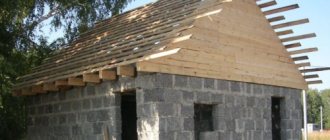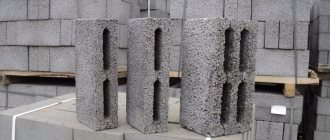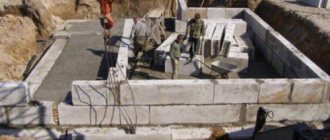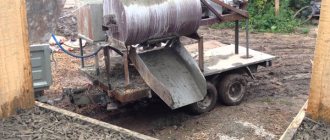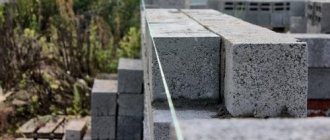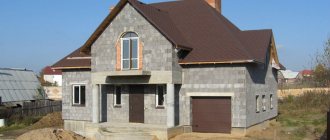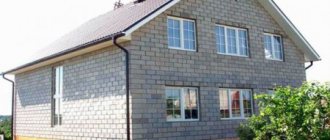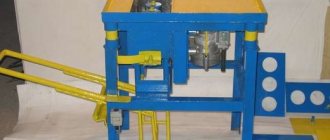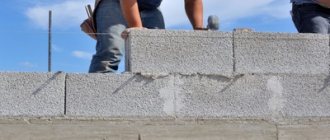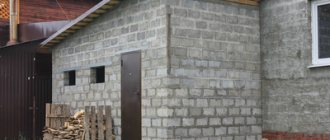This material has excellent thermal insulation properties, good geometry and low weight, for which it has become loved by construction specialists.
The cost of the blocks is low, but if you plan to build a house, a bathhouse, or a garage on one site, you will need a large amount of stone.
You can make it yourself, but first you need to familiarize yourself with the nuances of production.
Ingredients for expanded clay products
To make blocks of expanded clay and concrete yourself, you will need the following components :
- expanded clay;
- cement;
- sand;
- water;
- boards;
- metal sheets.
It is better to select sand that is clean, sifted without impurities.
Portland cement must also be of good quality, otherwise the finished stone may crack over time. It is better to take Portland cement grade M400; you will need one part of it. It is better to take 6-8 parts of expanded clay - it all depends on what porosity of the finished product you want to achieve.
Often 350-500 kg of expanded clay per cubic meter is used . You can measure with ordinary ten-liter buckets: one such bucket contains about 3-5 kg of expanded clay, depending on its fraction.
For the specified amount of expanded clay and Portland cement, take 2 parts of sand - its fraction should be less than 5 mm. 0.8-1 part of water is used, but its amount is often determined by the fact: when the mixture has reached the desired consistency, they stop adding water.
Note! As an air-entraining additive, as well as for the plasticity of the mass, it is recommended to add Fairy or washing powder in the amount of 1 part.
Composition of the solution
In the process of manufacturing expanded clay concrete block elements, it is important to use high-quality raw materials, used in proportions strictly specified by regulatory documents. The composition of expanded clay concrete includes the following components:
The material is prepared from components that are related to each other in the required proportion.
- Cement. To make expanded clay concrete durable and of high quality, experts advise adding cement of a grade not lower than M400 to the solution.
- Expanded clay. A material used instead of crushed stone, characterized by a porous structure and low weight. For the production of expanded clay blocks, a fraction of 5-10 mm is used.
- Sand. Should not contain any admixtures of clay or black soil. Used as a filler to create the skeleton of a block element. Acceptable sand fractions are medium and coarse.
- Water. The product will be of better quality if purified water is used.
To increase the plastic properties of expanded clay blocks, it is allowed to add dishwashing detergent or liquid powder to the mass. The chemical reaction between the components promotes the formation of air micropores inside. Thanks to this effect, the coefficient of moisture and frost resistance increases, which has a positive effect on the quality of the finished product.
Tools and equipment
In order to start making expanded clay concrete blocks with your own hands, you also need to prepare all the tools and equipment. If only a few blocks are made, then it is permissible to use a conventional large-sized plastic trough, where the mass will be mixed.
If you plan to make a lot of stone, then it is better to prepare an electric concrete mixer of at least 130 liters: with the help of this equipment the process will go faster.
You also need to prepare:
- vibration machine;
- crusher;
- molds for expanded clay concrete;
- cart;
- bucket;
- shovel.
The molds are made by hand from boards or galvanized metal sheets . You can also purchase ready-made forms - they are sold at the same factories that themselves produce expanded clay concrete blocks.
Preparation of formwork
The interior walls must be lubricated with used motor oil.
To shape the future product, you will need wooden boards at least 2 cm thick, a thin metal sheet, a hacksaw, a tape measure, and a pencil. As for sizes, they usually choose standard ones, for example, brick or cinder block. Having decided on the size, you can start marking, and then use a hacksaw to cut out 3 parts from the boards: a pallet and 2 halves in the form of the letter “L”, then connect everything with metal corners. To make it easier to pull out the blocks, a sheet of metal is nailed to the inside of the boards, and if it is not found, the mold is carefully treated from the inside with machine oil. And so that the shape does not change its size, special closures are made at the ends of the halves.
Return to contents
Step-by-step creation process
Once all the materials and tools are ready, you can begin the process of making building stone. There are 2 methods of this procedure: using a vibration machine and using improvised means.
With improvised means
At the first stage, it is necessary to make a mold for casting the material .
To do this, take wood boards or metal sheets. First, mark the required dimensions, then use metal scissors or a jigsaw (if woodworking) to cut out the necessary parts.
Using welding or nails, you can knock down the side L-shaped parts, then connect the workpiece elements using steel angles.
For the base, it is still better to use a thin sheet of metal : it is nailed to the bottom of the molds - the workpiece is completed. Then follow the instructions for making the blocks:
- Mix the solution. For small batches, mixing is done in a trough or bucket; if the batch is large, then use a concrete mixer.
- Casting.
The finished mass is cast into pre-made molds. A little advice: if production takes place using improvised means, then it is better to make individual molds rather than a whole workpiece. This will make it easier to pour the mixture. After pouring the mixture, it is carefully compacted to allow excess air to escape. If air chambers are required, glass bottles are used, which are lubricated with oil on the outside and placed upside down in the mixture. - The blocks are left in the mold for several days. When the composition has set, it can be removed from the mold and sent for drying.
Drying takes place outdoors, weather permitting. The temperature regime for normal drying of blocks is at least +15 degrees, and preferably +20 degrees. The drying room should be spacious and the floor surface should be level.
On a special machine
The technology differs from the previous one in that the process is more automated, so things go faster. Several stages of work :
At the first stage, the forms are prepared and the solution is mixed in a concrete mixer.
To do this, first pour water and detergent inside. Then expanded clay is poured in and everything is mixed. The next step is to add cement, and finally add sand. The mass is mixed well for 3-5 minutes.- The finished solution is poured into molds. They are pre-lubricated with machine oil and placed on a flat surface. The room where work takes place should not be too humid.
- To compact expanded clay, which will float to the surface due to its low weight, a special vibrating machine is used. The mold is installed in the equipment and the vibration function is turned on. While the equipment is running, the mass is well compacted.
- Drying. After just 1 day, the stone can be removed from the formwork and sent for drying. The product will take 2-3 days to dry.
This method differs from the previous one in its speed . Here, a person does not need to compact the mass in the mold himself, since the machine will do everything in a matter of time.
Important! Purchasing vibration equipment is beneficial if you plan to put production on stream.
Performance characteristics
Compared to other building materials, expanded clay concrete has improved performance characteristics and a number of advantages. Therefore, it was possible to establish not only its mass production on an industrial scale, but also the manufacturing process at home, using the simplest equipment.
The main advantages of expanded clay blocks are:
- high strength - the constructed structures are reliable and durable;
- low weight - with high strength, objects are obtained that do not exert much pressure on the base of the foundation;
- thermal insulation - due to low thermal conductivity, the material retains heat indoors, which reduces the cost of heating rooms in the cold season;
- no rotting - the material is very resistant to harmful microorganisms and mold, and is not subject to rotting processes due to the high level of dampness;
- environmental cleanliness - expanded clay concrete is not harmful or dangerous to the environment; it does not emit any pollutants into the atmosphere or soil.
Due to their performance characteristics and properties, blocks have become a popular material in the construction of buildings for both residential and industrial purposes. The low cost of production is also attractive, allowing you to experience significant savings when drawing up construction estimates. For example, laying expanded clay concrete blocks will require half as much cement mortar as brickwork. At the same time, the speed of the work process itself increases by 3.5 times.
Possible difficulties and errors
There are several mistakes that beginners and experts can make when creating blocks of expanded clay and concrete on their own:
- It is not recommended to steam the mixture that has just been poured into molds - this will cause it to crack.
- If you still plan to process the products with steam, then it is better to first remove them from the molds.
- Do not dry molded blocks in precipitation or direct sunlight.
- The solution must be prepared only in the prescribed ratio, maintaining the desired consistency.
Some builders forget that after pouring the mixture, it must be compacted . If this is not done, then pores will form in the structure of the finished block, which are undesirable for the structural type of material. This will make the finished stone less durable.
Drying
In the form, the blocks will dry for about 2 days. During humid and rainy periods this time can be longer. It is better to store ready-made expanded clay concrete blocks on pallets of 3-4 pieces in a row. An air gap between the pallets will allow the finished products to dry more evenly.
The blocks removed from the mold must be finally brought to condition under a canopy, so that direct rays of the sun and raindrops do not fall on them. In hot weather, they are moistened with water and covered with cellophane film. You can start working with them after 1-1.5 weeks. However, the ideal option would be to dry them for a month - only during this time will the cement fully gain brand strength. Before starting work, the blocks must be cleared of irregularities. You can remove dried mortar deposits with a regular knife.
Pros and cons of self-production
Several advantages of making blocks with your own hands:
reducing the cost of building a house;- the ability to independently regulate the composition of the stone;
- the ability to work with available tools;
- independent monitoring of the quality of materials;
- It is possible to implement blocks.
The disadvantages include the duration of the work, but if you purchase a special machine, the time spent on work will be reduced . Again, the machine costs a lot of money and will pay for itself if you plan to put production on stream.
Types of expanded clay blocks
The ends of the blocks can be grooved, flat, or made using the tongue/groove principle. For use on corners, one edge can be smooth. In addition, the corners can be rounded or straight. On the supporting surfaces (where the mortar is placed), grooves can be formed for laying reinforcement. These grooves should be located at a distance of at least 20 mm from the corner.
An example of tongue-and-groove hollow-core wall expanded clay concrete blocks and their prices
Blocks come with or without voids. The voids can be through or not; they are placed evenly, perpendicular to the working surface. The maximum permissible weight of a building block made of lightweight concrete is 31 kg. The standard standardizes the thickness of the walls that enclose voids:
- outer walls - at least 20 mm;
- partition over blind voids - at least 10 mm;
- between two voids - 20 mm.
Voids are often made flat - in the form of cracks. The number of “lines” with voids determines the thermal conductivity coefficient of the material. The more lines of voids, the warmer (and “quieter”) the wall will be. Air is known to be a poor conductor of heat. At least worse than concrete. Therefore, splitting a block with voids gives a good result.
Grades by density and compressive strength
Based on strength and thermal conductivity, expanded clay concrete blocks are divided into two categories: structural and structural-thermal insulating. Each group may contain products of different densities. Density is the mass of one cubic meter of material in a dry state. The approximate value appears after the letter D. For example, D600 - the mass of a cubic meter is 600 kg, D900 - 900 kg. And so on.
- Structural and thermal insulation: D500 B0.75 to B1.75;
- D600 B1.0 to B2.5;
- D700 B1.5 to B3.5;
- D800 B2.0 to B3.5;
- D900 B2.5 to B7.5;
- D1000, 1100 B3.5 to B10;
- D1200, 1300, 1400 B5 to B10.
The size of the expanded clay concrete block is determined by standards
- D1100 V 12.5;
In private housing construction, structural and thermal insulation blocks are usually used. For the construction of external walls of one-story houses, expanded clay concrete blocks of grade D700 or D800 are used; for internal unloaded partitions, lower grades can also be used.
What is the cost?
To decide whether it is worth starting to produce expanded clay concrete on your own, you need to calculate the cost of the finished stone.
For example, you can calculate how much it will cost 100 liters of the finished mixture, which will need to be poured into molds. At average prices in the Russian Federation:
- cement - 4.8 rubles. per kg;
- sand – 3.4 rub. per kg;
- expanded clay - 1.4 rubles. per kg.
According to the above proportions, 100 liters of mixture will require 7.7 kg of cement, 23.1 kg of sand, and 61.5 kg of expanded clay. 7.7 liters of water are added here. When recalculated, it turns out that 100 liters of the mixture will cost about 201 rubles. From 100 liters of the finished mixture you can make about 10 blocks.
Therefore, 10 blocks will cost 201 rubles, and 1 block will cost 20 rubles. Here you can add the costs of transportation and electricity. In total, one block will cost around 25 rubles.
This is much cheaper than purchasing material from a factory or store, where it costs twice as much.
